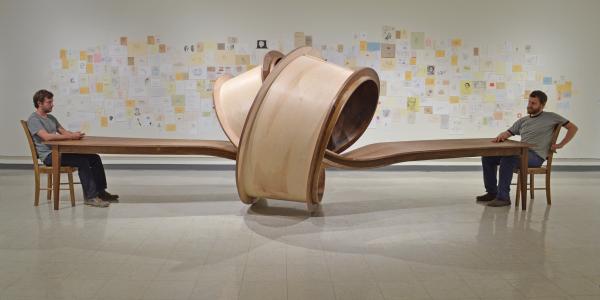 When is a table more than a piece of furniture? For Assistant Professor Michael Beitz, it’s when it’s a work of art.
When is a table more than a piece of furniture? For Assistant Professor Michael Beitz, it’s when it’s a work of art.
A sofa twisted into a huge knot, a dining table with a rollercoaster-like arch, a picnic table that droops limply over a patio railing. Beitz manipulates wood into flexible forms that bend, curve and meander in different directions as a way to create public meeting spaces through community artwork.
His sculptural transformations of furniture serve as a commentary on aspects of the human condition.
“My work is a hybrid between art and furniture making,” Beitz said. “I’m interested in integrating ideas about relationships and family dynamics into objects and the spaces they are in. My furniture pieces also function as an interpretation of my own interpersonal relationships.”
Using chisels, he shaped a 3D figure of a disposable coffee cup into a long piece of wood as an observation on our disposable culture. While working on the sculpture in his studio in the Visual Arts Center, Beitz sat on an old oak chair into which he had drilled holes of various sizes.
“Because the chair looks more interesting that way,” he said.
Most of his furniture-based work incorporates an obstacle or spatial distance in the piece with a goal of addressing a sense of intimacy or alienation as a design principle.
One of his public art projects was a giant picnic table made in the shape of a question mark. A small, round detached picnic table served as the period. It temporarily sat in the plaza outside the Visual Arts Center on campus this summer until it was installed on the campus of the University at Buffalo.
“I love changing the function of spaces into more human-friendly zones,” he said. “It’s interesting to see a space that’s normally used as just a walkway be transformed into a place where people gather and talk and relax.”

Beitz works in a variety of media, although his recent work draws on his history as a furniture maker. For several years, he worked with master furniture maker Wendell Castle, an acclaimed artist of the American art furniture movement. The experience was an “extreme craft boot camp” for Beitz, teaching him to “see” with his hands by feeling the wood and noting its imperfections.
His work has been in a number of art shows, most notably the Dismaland exhibition curated by Banksy, a well-known street artist. He was also a featured artist in a CNN.com article titled 18 Surreal Sculptures That Will Shock and Amuse You.
Before moving to Boulder last year, Beitz lost nearly his entire life’s work plus personal belongings in a devastating fire that roared through the Wisconsin artist collaborative warehouse that housed his studio. Other than a few art pieces in private collections, nothing remains. Even hundreds of his sketches for project ideas he had accumulated over decades were destroyed.
“When I lost all my work in the fire,” he said, “it made me wonder, ‘Do I even exist anymore?’ Now I’m questioning what I’ll spend the rest of my life making.”
In 2015, Beitz joined the faculty of the Department of Art and Art History where he teaches undergraduate art foundations, a class that introduces students to a variety of media, including drawing, painting, printmaking, 3D sculpture and digital. This learning environment is empowering for students more used to touching smartphone screens than sculpting clay.
To help students become engaged in the creative process, Beitz assigns what he calls a 24-hour drawing project. Students must log 24 hours of time spent drawing the subjects of their choice in a single 24” x 32” drawing.
“They clearly developed a relationship with their artwork,” he said. “That’s the most I could ask for, that they fall in love with their work. Through making things, you learn so much about yourself and your surroundings. We all have interesting artwork in us to discover.”
His next project is two outdoor tables commissioned for the Hilton Embassy Plaza in Boulder. The tables look like they’re trying to escape their surroundings by climbing up a wall.
“I have a zillion ideas,” Beitz said. “I discover new directions when I make things.”
